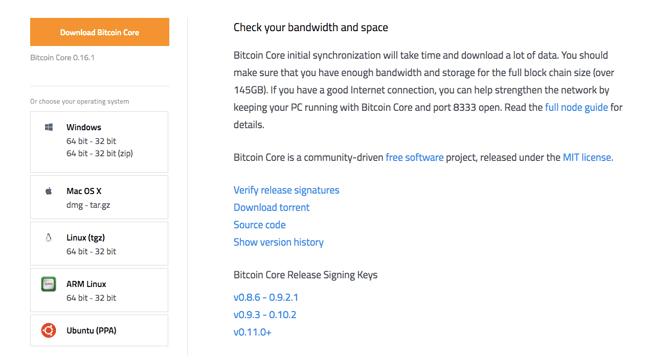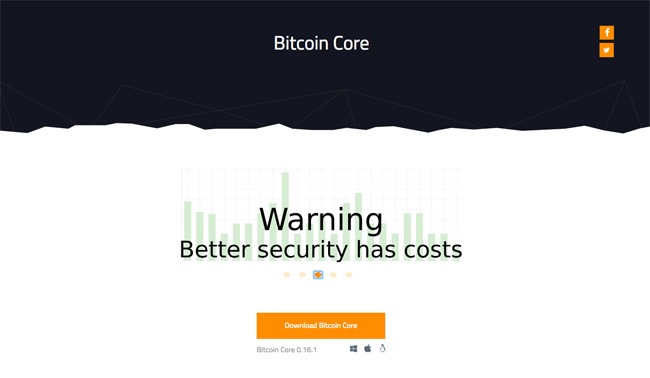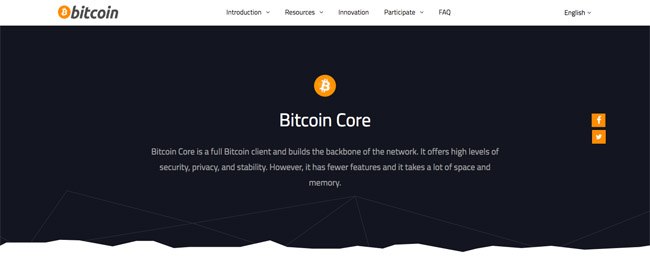The need to use an official wallet that comes right from the Bitcoin network itself is especially notable for new cryptocurrency users. New cryptocurrency users are looking for that reliability and trust factor which can only come with using “official” means in order to keep their Bitcoins safe, secure and away from the prying eyes of malicious parties.
While it is not often recommended, such a solution does exist in the form of Bitcoin Core Wallet, which lets users keep their Bitcoin safe through a software that was developed and functions as the main doorway to the Bitcoin blockchain.
Often termed as the “official” wallet for Bitcoin, the Bitcoin Core Wallet is part of the original implementation of the Bitcoin software, which had been developed by the creator of Bitcoin, Satoshi Nakamoto.
However, while the Bitcoin Core Wallet remains the first implementation for any cryptocurrency wallet, its setup and pertinent processes ask for the fulfilment of a few requirements and technical knowledge which some users might not be able to fulfil.
Therefore, in order for new and even old users learn about this technical wallet in a detailed manner, we have put together a comprehensive guide that talks about its history, its functionalities, its security capabilities as well as its ease of use.
So without any delay, let’s go ahead and start learning about Bitcoin Core Wallet, the official wallet of the Bitcoin blockchain.
History of Bitcoin Core Wallet
Before you learn more about the Bitcoin Core Wallet and start making preparations to go and download it for yourself, there’s one thing that you might like to know first: the Bitcoin Core Wallet is not a standalone application but a small part of a blockchain implementation software.
You may think of this as installing a suite of applications on your device. Even if you only want to use one of the applications available within all the offerings, you would need to install the full suite in order to get your hands on that one desired application.
With that being said, the blockchain software implementation for Bitcoin in itself might come in handy if you would like to dabble in technical uses of it.
Originally named as just “Bitcoin”, the software implementation for Bitcoin’s blockchain network was later renamed to “Bitcoin Core” to avoid any confusion originating by having a name similar to the cryptocurrency itself.
Bitcoin Core had first come to the surface in January 2009, when Satoshi Nakamoto unveiled the digital currency that has now changed the lives of hundreds of thousands of people and brought the blockchain technology to light for this innovative invention to influence future generations.
Right from the start, the Bitcoin Core software was intended to be a transaction verification engine that connected users with the Bitcoin blockchain and turned their computer into a full node that remained operable on the network.
A cryptocurrency wallet for Bitcoin was included in this implementation by default. While the Bitcoin Core client was originally only available for Windows, after numerous upgrades and improvements, it finally got to the point where its implementation was available for other operating systems such as Linux and Mac.
Numerous other features pertaining to the blockchain’s operations were added to Bitcoin Core along the way, which have all been compiled in its latest release at version 0.16.0, which was released on February 26, 2018.
However, even with all of its capabilities, the numerous features which come together to make the Bitcoin Core client an overall technological powerhouse are not available in their standalone version. They were never meant to be offered individually in the first place.
That is why, when you think of using Bitcoin Core Wallet, you cannot separate that thought from having to use Bitcoin Core. If you are to utilize the Bitcoin Core Wallet, you will need to use the Bitcoin Core software in order to pass through the implementation and use the wallet itself.
Bitcoin Core Wallet Review: What Does Bitcoin Core Wallet Do?
Bitcoin Core Wallet is available within the Bitcoin Core software both as a graphical user interface (GUI) or through command line prompts in order to provide users the capability of accessing their Bitcoins through their preferred method.
Since the Bitcoin Core Wallet is built within the blockchain implementation itself, users can rest assured in the fact that their funds remain highly secured through the safety and reliability of blockchain technology.
With the ability to create intricate seed phrases to access the digital assets in the first place, the Bitcoin Core Wallet remains impenetrable to malicious hacking and breaching attempts.
The GUI of the Bitcoin Core software remains especially prevalent in the Bitcoin Core Wallet, where users can easily select their private key/passwords/security phrases just by navigating through the clean user interface.
Bitcoin Core Wallet is not only meant to keep users’ funds safe, but it also allows them to send and receive funds easily through a native wallet address. With the newer capabilities that have been introduced in the wallet with full Segregated Witness (SegWit) support, transactions performed through the wallet have the ability to be executed faster and with a cheaper transaction fee.
Users are also able to set their transaction fee through the wallet when sending Bitcoin to another wallet address, and the system ensures that it provides near-accurate estimation through the Bitcoin Core Wallet interface.
The Bitcoin Core Wallet also allows users to save other wallet addresses to the user’s information so that they do not have to enter long and intricate addresses into the address bar every time they have to send money to someone who they frequently pay through Bitcoins. The identifiable information about these addresses also remains confidential and is only accessible to the respective owner of each Bitcoin Core Wallet.
With all these functions, Bitcoin Core Wallet also provides a backup option to its users, where they can save their wallet information in a single file in case they ever lose access to their device or need to migrate to or access another device.
This way, users do not have to go through the hassle of transferring their funds out of their Bitcoin Core Wallet to another provider in case they ever upgrade or change the device on which the Bitcoin Core client is set up.
Overall, as a standalone application, Bitcoin Core Wallet provides all of what you would expect from a high-level cryptocurrency wallet: immense security, ease of use, and high accessibility.
However, here comes the fact of the Bitcoin Core Wallet not being a standalone application but a small part of a large blockchain implementation client, and that is where its offerings get that dreaded “conditions apply” asterisk attached to them.
How to Setup THE Bitcoin Core Wallet?

Setting up the wallet on your desktop or laptop is not something that could be completed in a matter of minutes or even hours, since you will not just be downloading a small fragment of application in terms of Bitcoin Core Wallet but will actually have to download and setup the Bitcoin Core implementation – which is a feat in itself.
Installing Bitcoin Core on your device is equivalent to downloading the whole blockchain’s data on it in order for it to be synced with all of the updated records before the implementation could become functional.
That is why, when you decide to go for Bitcoin Core Wallet as your primary wallet to hold your Bitcoins in, you will not just need to keep an open mind during the setup, but would need to have ample space in your hard drive in order for Bitcoin Core to even start working.
The Bitcoin Core client has seen many upgrades since its first implementation, and it is currently available to download here.
It requires more than 145 GB of disk space to set up and be operable. Furthermore, the client will also require frequent updates in order to stay up to date with the Bitcoin blockchain.

Other system requirements to run Bitcoin Core are for the user to have a capable motherboard – and if they have a GPU to boot, then it just makes the experience better. The desktop or laptop running Bitcoin Core also needs to have at least 2 GB of RAM, which would mostly be consumed by the application when it runs.
This also translates to the user to have an internet connection with a high speed and unlimited data plan, since running Bitcoin Core can eat up bandwidth sooner and faster than most of the other wallet applications, which again is because it is not just a wallet application but is the implementation of a whole blockchain in itself.
Once you have ensured that you have a machine and internet capable enough to run Bitcoin Core without any issues in fulfilling its requirements, you may put the Bitcoin Core setup to run. The initial setup can take from a couple of days to a week or even more so, depending on the speed of Internet that you have and whether or not it is being shared by other devices or applications.
Once Bitcoin Core finishes its initial setup, you may go ahead and start to set up the Bitcoin Core Wallet through it.
Once again, it is prudent to remember that you are not just limited to running Bitcoin Core Wallet through Bitcoin Core, but can also delve into running a full node on the Bitcoin network even when you do not have to use your Bitcoin Core Wallet.
You can look into verifying other transactions by trying your hands at Bitcoin mining as well – but only do so if you have a system to support mining operations, as running Bitcoin Core for mining on everyday machines can fry them up pretty fast.
However, since the objective of this guide is to learn more about Bitcoin Core Wallet, let’s focus on that aspect again.
As explained earlier, setting up Bitcoin Core Wallet through the GUI is easy, and you would not need to have any knowledge of coding languages in order to create your private key and have a functioning wallet for yourself. All of the options are easily laid out and can be accessed without any issues.
All that you will need to do to get your Bitcoin Core Wallet up and running is to set up your security options, create your wallet addresses, and… that’s it.You can then deposit Bitcoin to your new Bitcoin Core Wallet and start making outgoing transactions as well.
However, since all transactions on the Bitcoin network are posted publicly with the users’ addresses and the amount that has been transacted, any transactions made through Bitcoin Core Wallet follow the same method.
Therefore, those who know your wallet address’ association with your identity might be able to track your transactions through the posted ledger.
But since this is a network feature that is implemented all over it, there isn’t much that Bitcoin Core Wallet can do to reverse it.
That being said, for added privacy, you may also use Bitcoin Core with Tor – the privacy-centric anonymizing solution which helps users hide their IP addresses. This way, you can ensure that it is not that easy for your real identity to be tracked in case someone is looking into your IP address information.
Bitcoin Core Wallet Review: Customer Support
Satoshi decided to practice their right to privacy and as a result chose to walk away from all ongoing Bitcoin support, and that action led to the support for Bitcoin network’s to fall into the hands of its users, who actually ended up doing a tremendous job of it by stepping up to the challenge and bringing Bitcoin network to the number one spot by market cap in the whole world.
While it is true that the Bitcoin network has its issues in terms of scalability, longer transaction times and higher transaction fee in the face of network demand, the supporting teams of developers and programmers that keep working for the betterment of the Bitcoin blockchain are working to bring about updates that would resolve these issues for Bitcoin soon.
Similarly, since Bitcoin Core is an open-source client, anyone can contribute to its code and propose improvements to the overall network, which can be implemented after discussions that may or may not lead to consensus on such proposals.
The MIT Digital Currency Initiative and Blockstream are just two of many entities that contribute towards the development of Bitcoin Core both through funding and developmental efforts.
Other notable organizations dedicated to the growth of the Bitcoin network also keep contributing to Bitcoin Core, and the implementation thus has some of the most proficient of minds in the technology industry working on it.
Should Bitcoin Core Wallet Be Selected as a Primary Wallet or Trading Platform?
If you intend to use Bitcoin Core for its other features just as much as the Bitcoin Core Wallet, then selecting the Bitcoin Core Wallet as your go-to service for storing your Bitcoins would be a logical choice, since very few wallets could provide the same level of security that one being operated through a blockchain implementation would do.
However, if you do not have any other uses in mind for the Bitcoin Core implementation and only want to download it for the Bitcoin Core Wallet, then it would be just as smart to not go ahead with the decision of making it your primary wallet.
Going through the whole process of downloading Bitcoin Core to your system, as secure as it may be, and keeping a program on your computer that takes over 145 GB to set up and then takes about 500 MB per day to function as a full node would provide you with more hassles and ongoing hardware issues even if you get immense security for your Bitcoins in return.
On the other hand, if you are looking to keep your Bitcoin safe to the extent where you are willing to put your hardware assets to use in order to accomplish that objective, then instead of dedicating hundreds of GBs in hard drive space to your wallet, you may invest some funds into hardware wallets such as Trezor or Ledger.
These wallets could keep your funds just as safe and provide you with access to them as soon as you plug your devices into your computer. It would, of course, involve some monetary costs, but you would be spending that much over a few months in terms of hard disks and internet if you keep using Bitcoin Core.
